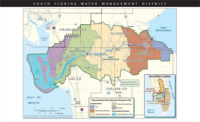EPA Orders Florida to Improve Everglades Water Quality
Bulldozers may soon be pushing dirt in the Everglades following the issuance Sept. 3 of new marching orders from the U.S. Environmental Protection Agency to the State of Florida to improve the quality of water entering the Everglades Protection Area. The agency was acting in response to pressure from an April U.S. District Court decision ordering EPA and the state to begin enforcing the water quality standards mandated by Florida’s 1994 Everglades Forever Act and the Federal Clean Water Act.
Work is under way on the 2,000-acre Lakeside Ranch Stormwater Treatment Area, but EPA has ordered Florida to create 42,000 acres more south of Lake Okeechobee.
To comply with the court order, EPA has notified Florida that clean water standards for phosphorus are not being achieved in all parts of the Everglades and that further reductions of phosphorus pollution are needed in the area south of Lake Okeechobee. Phosphorus is a naturally occurring nutrient, but the bulk of the phosphorus entering Okeechobee and the Everglades now is from runoff of farms north of the lake.
Artificial wetlands known as Stormwater Treatment Areas are the means of slowing the flow of water and cleaning it before it enters the sensitive Everglades ecosystem. EPA’s order to the state, known as the Amended Determination, calls for adding 42,000 acres of STA to the 60,000 acres already in place. The federal agency said that land already in state ownership, plus the land that the West Palm Beach-based South Florida Water Management District recently agreed to purchase from U.S. Sugar Corp. of Clewiston, Fla., will accommodate the required STA expansion.
The Amended Determination includes a schedule with detailed milestone dates for permitting, design and construction of five separate projects. Design for the C-139 flow-equalization basin in Hendry County, for example, is to begin this November and construction of the final treatment area, STA 1W, is to be completed by November 2018.
The Water Management District agreed in August to purchase 26,800 acres of U.S. Sugar land for $197 million, with options to purchase as much as 153,000 acres more within 10 years. Closing is scheduled for October.
The court’s April order was a “pretty momentous decision,” says Thom Rumberger, chairperson of the Tallahassee, Fla.-based Everglades Trust, because it has forced the state and federal environmental agencies to accelerate their actions under threat of being ruled in contempt. “The issue as always is going to be money,” he admits. Rumberger guessed the cost could run from $1 billion to $2 billion before all the work is done.
The organizations responsible for organizing, planning and executing the work are not saying much about the EPA order yet. Both SFWMD and the U.S. Army Corps of Engineers, the district’s partner in the Comprehensive Everglades Restoration Plan, are studying the EPA determination and reviewing the projects it requires, according to their spokespeople.




